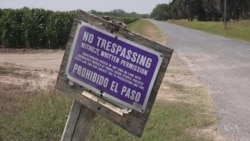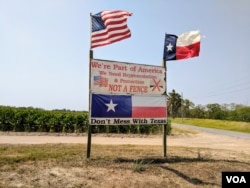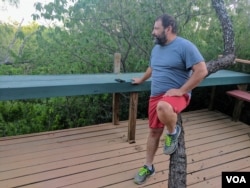Southbound on Calle Milpa Verde towards Mexico, you pass a border fence and a U.S. Customs & Border Patrol (CPB) vehicle. At the end of a palm tree and brush lined-road, just before the border, is the property and ranch house of “definite gung-ho Texan” Pamela Taylor.
Taylor has seen her neighborhood change since she and her husband bought their “little plot of land” in 1948 — an era when she would take her kids to play in the sand by the river, and when Mexican guest-treaty workers would bring her fresh tortillas in the morning.
Nearly 70 years later and already partially fenced off from the rest of the U.S., Taylor faces the possibility of losing her land to President Donald Trump’s proposed border wall. In recent years, the Rio Grande River Valley has been a preferred entry point for undocumented immigrants, making it a prime candidate for the wall.
“I’m waiting,” Taylor told VOA.
Taylor voted for Trump in hopes that he would do something about the undocumented immigrants who traverse her property but not a wall. And if a condemnation letter – legal notice the government wants to build the wall on her property – were to arrive at her doorstep, she’d go to court.
"My husband and I, we worked hard for everything we got. We did not ask anybody to give us anything, okay?” Taylor said, echoing the belief of many Americans that property ownership is a right that should not be interfered with by anybody, including the government.
Asserting eminent domain
The U.S. government’s ability to acquire private property for public projects like the wall is called eminent domain. The government must pay for the property, and property owners have the right to contest both the price and condemnation in court. To build the rusty metal fence near Taylor’s property — an initiative of President George W. Bush in 2006 — the government issued 330 condemnation orders.
Watch: What is Eminent Domain?
Efrén Olivares, director of Racial and Economic Justice at the Texas Civil Rights Project (TCRP), explains that 90 remain pending in court, nine years after they were initiated.
“They are still open…and in many of those places, there is no border fence built,” Olivares told VOA. If Trump were to get his whole wall, he says, “they will need to condemn a lot more land, which will mean that they will need to file a lot more lawsuits.”
TCRP has provided pro bono counsel to property owners who need it. Staff attorney Emma Hilbert notes there is a “huge discrepancy” in settlement amounts between those who found representation and those who did not — some as low as $1,000, others in six or seven figures, as documented by NPR.
This time around, Hilbert says her team is better prepared.
“We are really formulating a comprehensive litigation and education plan,” said Hilbert, “and also preparing landowners so that they are prepared ahead of time, ideally before the government even approaches them.”
Trump currently has sufficient funds to pay for only 11 kilometers of his 1,600 km-long border wall or $20 million dollars. The estimated total cost, meanwhile, ranges from $15-25 billion, which may or may not include oft-hidden costs like land acquisition and its legal fees.
Whatever fees are included, they are not enough in Taylor’s view. She says the people who live in the Rio Grande Valley are not rich.
“What makes anybody think that they can go in and take away the homes of those people? And say, ‘Well sorry,’” she says. “I don't think it's right. I think they need to start thinking about the people here before they do anything."
Resistance ‘to the end’
Daniel Ernesto Villarreal, a bail bondsman from Rio Grande City, was born and raised in a 16-acre lush-green property off the town’s Main Street, where his family once raised cattle and horses.
There, as he gazes toward the borderland, the steady flow of the Río Grande is audible.
“One of the prettiest things about this property is that we do border the river, and we do have a little bit of waterfront property,” Villarreal said. “The wildlife is second to none.”
Villarreal, who shares the property with his mother, fears that the wall could very well pass through their backyard, since it lies in the non-flood zone, but he is crossing his fingers that it never comes to that.
“We are not rich … I’m pretty sure that we are going to be enticed by some kind of money, but it doesn’t compare,” Villarreal said. “[It] doesn’t compare to the luxury that we would be losing.”
Villarreal vows he wouldn’t go down easy in the case of a lawsuit. His plan can be summarized in one word.
“Resistance,” he said, repeating the word. “Fight it to the end."















